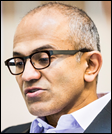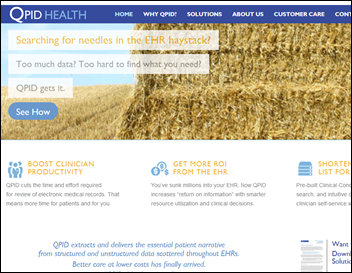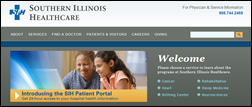Top News

National Coordinator Karen DeSalvo reorganizes the HIT Policy Committee. Also announced by ONC: only 972 EPs and 10 hospitals have attested to Meaningful Use Stage 2. Athenahealth users lead the EP Stage 2 attestation by far. Clearly ONC’s budget and influence are shrinking as disenchantment with the Meaningful Use program grows and providers focus on more strategic goals than lapping at Uncle’s Sam’s ever-distancing carrot.
Reader Comments
From McLayoffs: “Re: McKesson. Decimated their ranks last week, so I wouldn’t be surprised if they sold off that business. It’s not one that John Hammergren ever wanted to be in, but inherited when he took over. All non-essential implementation teams were dissolved and upgrades are rumored to be handled by national support. A lot of good people were lost last week. I’m not surprised that Siemens is calling it quits as well, with Epic dominating the market. I’m even seeing Cerner to Epic conversions now.” Unverified.
From Punch Bowl: “Re: Nuance. Acquiring Notable Solutions, Inc.” Unverified. NSI offers solutions for document capture and forms processing to a variety of industries.
From Kites Away: “Re: research question for your audience. Is strategic planning a useful exercise? Why or why not?” I will let readers weigh in. My opinion is that it’s a good exercise even though the assumptions and predictions often turn out to be wildly off. It makes people focus on the current state and to consider the array of possible future states.
HIStalk Announcements and Requests
This week on HIStalk Practice: Key takeaways from the 2015 proposed physician fee schedule. The ONC Health IT Policy Committee presents the latest round of Meaningful Use attestation numbers (and notes the vendors leading the pack). Cigna creates 100 collaborative care arrangements with large physician groups. The Accountable Care Coalition of Greater New York uses new grant money to launch a medication adherence program, while Milwaukee Health Services uses new funds to upgrade its EHR. Online consumer service providers and the DMV pilot a patient identity management program. Thanks for reading.
This week on HIStalk Connect: Dr. Travis breaks down Rock Health’s recent “Mid-Year Digital Health Funding Report.” In Europe, the $2 billion Human Brain Project is under threat of boycott from the scientific community over its hard line stance on funding out-of-scope projects. Syria is getting international support through an ICU telehealth program that is helping resolve the country’s physician shortage. AdhereTech raises a $1.25 million Series A for its connected pill bottle.
I received two items from readers that I’m going to decline to run because I don’t think it’s fair to the companies involved, but I want to explain why. First was a healthcare IT vendor CEO who was arrested for battery, which I don’t think is fair game because it’s personal and being arrested isn’t the same as being found guilty. Second is a lawsuit brought against a company that alleges it broke its contract with an offshore development shop, which has the same problem in being just an allegation so far. I like good rumors and gossip as much (probably more) than the average person, but both of these documents name people who shouldn’t be tried on the pages of HIStalk. I’ll report the final legal decisions once they are out.
Acquisitions, Funding, Business, and Stock

Revenue cycle vendor RevSpring acquires Talksoft, which offers an automated appointment reminder service.

Allscripts acquires UK-based Oasis Medical Solutions and will implement its Oasis Patient Administration System as a single-source solution for the UK market.

USA Mobility, along with its previously acquired Amcom Software, changes its name and Nasdaq ticker symbol to Spok (pronounced “spoke”).

Oncology data analysis vendor Syapse raises $10 million in a Series B funding round. Its product integrates genomic information with the EMR to display data for decision-making, suggest treatment plans, and track outcomes.
Sales
Centegra Health System (IL) adds revenue performance improvement solutions to its existing MedAssets agreement.

Carrus Hospitals (TX) will deploy Medhost’s clinical and financial solutions via the company’s hosted Medhost Direct platform.
Memorial Sloan Kettering Cancer Center will implement Allscripts dbMotion and continue its use of Sunrise EHR.
People

Health Data Specialists promotes Chad Jones to Cerner practice director.

Harold Paz, MD (Penn State Milton S. Hershey Medical Center) is named EVP/CMO of Aetna.
George Murillo (Leidos Health) is named western area VP of Orchestrate Healthcare.
Announcements and Implementations
Awarepoint announces the availability of awareAssets V3.0 for RTLS-based asset tracking and workflow optimization.
Lexmark’s Perceptive Software launches Perceptive Cloud Share, a cloud-based content management system for video, images, and other rich media.
DSS adds real-time abnormal lab results alerts to the VA’s VistA CPRS Version 31.
Elsevier launches PolicyNavigator, a knowledge management tool for healthcare policies and procedures.
Healthcare Engagement Solutions launches the Uniphy clinician communications platform.

MediSafe releases its medication adherence app for Google’s Android Wear smartwatch technology.
Government and Politics
The HIMSS EHR Association weighs in on HHS’s proposed Meaningful Use changes, saying pretty much the same thing as other groups before it: (a) turn the proposed rule into a final rule quickly and without changes since providers are otherwise forced to make decisions blindly; (b) define the types of delays that are acceptable for not implementing 2014-certified EHRS – vendor delays, lack of provider resources, lack of local interoperability options, etc.; (c) simplify the combinations stages, objectives, and EHR certification year; (d) simplify the proposed CQMs; (e) delay MU Stage 3 to avoid the same rush and confusion that accompanied the rollout of Stage 2.
A tiny observational study published in Annals of Internal Medicine finds that the government failed in its attempt to make Healthcare.gov as easy for millennials to use as popular websites. Its recommendations: (a) allow clicking on health insurance terminology to bring up a definition; (b) make it clearer that preventive care is included in all plans offered; (c) make the dental insurance option clearer; (d) improve sorting and filtering of available plans; (e) explain the available tax credit and cost-sharing options that reduce cost; and (f) call “catastrophic” plans something else, such as “minimal” or “value.”

CMS designates non-profit Health Care Cost Institute as the first national Qualified Entity, meaning it can merge Medicare claims data with commercial payer data to provide price and quality transparency.
CMS gives Tennessee 10 days to fix its $35 million Medicaid eligibility system, saying it is preventing people from signing up for insurance on Healthcare.gov. CMS says state workers ignored requests to assign more people to the project and failed to help new users navigate its system. The state blames Northrop Grumman for missed deadlines and has paid the company only $5 million so far.

A GAO report says the VA-DoD integrated EHR (iEHR) plan met only one of six required conditions in FY2013. The VA and DoD abandoned their two-year-old plan to develop a single EHR in February 2013 due to cost and timelines, leading Congress to threaten to cut off 75 percent of the iEHR budget unless six conditions were met (define a budget, set a timeline, break out annual and total spending, define how costs would be shared, establish data standardization, and comply with government acquisition policies.) The only fully satisfied condition was creation of a cost-sharing schedule. The joint oversight group says the plan has changed to the point that the original goals no longer measure the program’s success, leading GAO to recommend holding the VA and DoD responsible for publishing accurate budgets, maintaining a deployment schedule, developing data standardization rules, and proving that they are indeed compliant with federal purchasing policies.
Other

Cerner increases the estimated cost of its new 16,000-employee campus to $4.45 billion and wants Kansas City’s tax commission to chip in an additional $110 million in tax breaks, boosting the total taxpayer support to $1.745 billion.

Quick — who’s the CEO of Microsoft? No, it’s Satya Nadella, and he plans to rejuvenate the company by moving from “devices and services” to “platforms and productivity,” emphasizing mobile-first and cloud-first.
Partners HealthCare seeks a $145 million loan to help it pay for a new building, raising its total debt to $4 billion. Part of that money was targeted for its $1.2 billion Epic implementation.
A Florida lawsuit questions whether release of information companies can charge lawyers more than patients for copies of their hospital medical records. An attorney became upset at being charged $1.00 per page by HealthPort for a client’s medical records when state law specifies $0.25 per page, but HealthPort says the lower rate only applies to patients even though it recently lost a case using that argument.

A new bond issue for Providence Health & Services (WA) gets high, stable rating, with its ratings agency noting that, “PHS has nearly completed its system-wide implementation of the Epic electronic medical record (EMR) system. Implementation has spanned many years, and has occupied a significant portion of the system’s capital budget. Outsized operating expenses related to Epic have suppressed margins but are now expected to reach a steady state going forward.”
Weird News Andy likes the idea of “virtual gastric banding” described in this article, where hypnotists convince patients they’ve had weight loss surgery, sometimes even causing them to lose weight afterward from the power of suggestion alone. Of course WNA questions the $1,500 cost in wondering, “Can the patient then hypnotize the hypnotist to induce memories of payment?” WNA also likes a rare case in which a man suffers a blood clot in his brain after head-banging at a Motorhead concert, leading WNA to suggest renaming the band “Subdural Hematoma.”
Bizarre: city police charge a 17-year-old boy with child pornography for sending explicit photos of himself to his 15-year-old girlfriend and then ask a judge’s permission to inject him with arousal drugs in a local hospital so they can snap new pictures to compare to those he allegedly sent. I immediately thought of the “sketch artist” principal’s office scene in “Porky’s,” not safe for work or for those with a non-warped sense of humor but possibly the funniest four minutes (shot straight through with no edits) in movie history.
Sponsor Updates
- PatientSafe Solutions’ Cheryl Parker shares how informatics nurses contribute to products roadmaps through analysis, compliance, consultation, coordination, facilitation. and integration.
- Lucca Consulting Group offers post-implement feedback and testimonials.
- MedData will participate in the Annual MI Emergency Medicine Assembly July 27-30 in Mackinac Island, MI.
- A report by Imprivata and the Ponemon Institute says pager inefficiency and the inability to use text messaging costs the average hospital approximately $1.75 million per year.
EPtalk by Dr. Jayne

One of the things I enjoy least about my work in the CMIO trenches is keeping up with the ever-present stream of new rules, proposed rules, and all the supporting documents that go with them. It shouldn’t be a surprise that only a very small percentage of Eligible Providers have attested to Stage 2 Meaningful Use. As of May 1, only 50 Eligible Providers were on the books. Although the individual measures are not that difficult, keeping up with the voluminous documentation on all of them is a chore, as is preparing the documentation needed for attestation and potential audits.
CMS hasn’t disappointed in releasing its proposed rule to update the Medicare Physician Fee Schedule in 2014. I didn’t have time to read the 600-plus page rule myself, but luckily one of my vendors digests the information for its customers and sends out the highlight reel. As we always suspected, parts of MU are becoming mandatory independent of the actual MU program. Physicians billing for chronic care management would be required to use an EHR certified under 2014 criteria.
I was excited to see that Medicare is considering coverage for telemedicine services, including psychotherapy and wellness visits. I question, however, exactly how the digital prostate exam (and I don’t mean high-tech digital) or other sensitive exam maneuvers can be done via telemedicine, although I agree that a lot of the preventive counseling aspects of an annual visit don’t require a face-to-face visit if you already have a good relationship with your patient. Although those services aren’t specifically part of the Medicare “Annual Wellness Visit” paradigm, they are recommended services.
Are we setting ourselves up to have different kinds of wellness visits for patients, such as the Medicare Annual by phone, the Medicare Annual in person, the “G-Code Special” for those physical exams that have to be performed in person, and more? Patients can barely keep track of the services they need at present without having to worry how they’re delivered. And you can bet that if we try to bundle any of them into other in-person services, we won’t get paid. The Medicare Annual Wellness visit does recommend biometric assessment. I’m not sure I trust my patients to report what the scale actually says and we’re not yet in the Star Trek world of the medical tricorder. Although coverage for telemedicine sounds great in person, it just goes to show that the devil is in the details.
One of the other things I enjoy least about my work is dealing with difficult physicians. Although I’m not responsible for physician discipline per se, I do have to provide input when physicians are creating issues during implementation and training. I had mentioned a few weeks ago that we would start deploying new practices after Independence Day. This week has not disappointed for sheer magnitude of “stuff you just can’t make up.”
One of our surgeons decided to book two elective cases at the same time as his prearranged EHR training, then demanded that we train him later that evening. What do you even say to that? They weren’t emergencies. Although our trainers are happy to accommodate evening sessions when requested in advance, they can’t do it on short notice due to family and other obligations. I really think that he hopes to stall his go-live by staying untrained.
His power play failed, however, and he only ended up short-changing himself since his partner showed up and training was delivered. He’s just going to have to play catch-up because we have 22 go-lives teed up behind this cohort and there’s no room for game playing. His partner was an absolute joy to work with and decided to move his own go-live forward. I’m betting the practice dynamic is going to be pretty interesting in the coming weeks. Hopefully positive peer pressure will win the day.
One of the things I enjoy most about my work is the people I have gotten to know over the years. Although it seems like there’s a lot of movement around the industry, especially among the sales force, there’s still a sense that we’re all in this together and a willingness to help out whether you work directly together or not. I was able to meet up with a friend who used to work for one of my vendors and learn about his adventures in a different part of the industry. Another consultant I worked with early in my career turned up on a project I’m peripherally attached to. It’s definitely a small world and I’m glad to have people with whom I can commiserate. Maybe if I’m lucky though one will read the 600 pages of federal regulations and give me the Cliffs Notes version.
Will trade wine for summaries – email me.
Contacts
Mr. H, Lorre, Jennifer, Dr. Jayne, Dr. Gregg, Lt. Dan, Dr. Travis.
More news: HIStalk Practice, HIStalk Connect.
Get HIStalk updates.
Contact us online.




























































































Merry Christmas and a Happy New Year to the HIStalk crowd. I wish you the joys of the season!